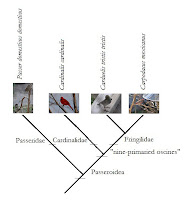 |
| Sitta carolinensis carolinensis |
 |
| Turdis migratorius migratorius (male) |
 Next lets jump to a different avian family and talk about bird #7, who was also positively identified by all as the American robin. The dark head indicates that this particular bird is a male, and a rather tenacious one at that. I watched this fellow dig for worms for quite some time before he moved onto the next yard. Despite being called robins, they are actually a type of thrush and belong to the family Turdidae. This family lies within the superfamily Muscicapoidea, which is a sister group to Certhioidea. The Certhioidea is the superfamily in which you can find the nuthatches. So in terms of familial relationships, the robin and the nuthatch are more closely related to each other than they are to any other birds in the quiz. There is no technical name for this "Turdidae + Sittidae" clade, but it is pretty well supported.
Next lets jump to a different avian family and talk about bird #7, who was also positively identified by all as the American robin. The dark head indicates that this particular bird is a male, and a rather tenacious one at that. I watched this fellow dig for worms for quite some time before he moved onto the next yard. Despite being called robins, they are actually a type of thrush and belong to the family Turdidae. This family lies within the superfamily Muscicapoidea, which is a sister group to Certhioidea. The Certhioidea is the superfamily in which you can find the nuthatches. So in terms of familial relationships, the robin and the nuthatch are more closely related to each other than they are to any other birds in the quiz. There is no technical name for this "Turdidae + Sittidae" clade, but it is pretty well supported.This "Turdidae + Sittidae" clade forms a sister group to the Passeroidea within the order Passeriformes so our cladogram grows a little more to incorporate all we know about the identified birds so far.
 |
| Baeolophus bicolor |
Passeriformes, however, is a very large order of "perching birds", so it's no wonder that there were a few more passerines in the quiz. One of the last two was bird #1, the tufted titmouse. I've always found this particular bird to be a handsome one, and was pleased to see not one, but two feeding together on that warm December day. Their grey crown and rusty flanks are easily noticed, and although flighty at times, this particular pair were the only two birds that allowed me to sit right next to the feeder as I photographed them. They almost seemed as interested in me as I was in them.
 |
| Poecile atricapillus |
 The last passerine in the quiz was bird #3 and like the previous three mentioned, it was also identified by as all a black-capped chickadee. At first I wasn't sure about this one. It easily could have been a Carolina chickadee, as the two different species are nearly indistinguishable from one another. At least physically. Fortunately, I got to hear them singing to one another, and the familiar "chick-a-dee-dee-dee" call was slow and low-pitched, indicating that they were in fact black-capped and not Carolina chickadees. Both the titmouse and the chickadee belong to the family Paridae, so like the nuthatch and the robin, they are more closely related to one another than they are to any other birds in the quiz.
The last passerine in the quiz was bird #3 and like the previous three mentioned, it was also identified by as all a black-capped chickadee. At first I wasn't sure about this one. It easily could have been a Carolina chickadee, as the two different species are nearly indistinguishable from one another. At least physically. Fortunately, I got to hear them singing to one another, and the familiar "chick-a-dee-dee-dee" call was slow and low-pitched, indicating that they were in fact black-capped and not Carolina chickadees. Both the titmouse and the chickadee belong to the family Paridae, so like the nuthatch and the robin, they are more closely related to one another than they are to any other birds in the quiz.
Paridae is nested within the superfamily Sylvioidea, which forms a sister group to the previously established "Turdidae + Sittidae + Passeroidea" clade. And all of these clades can be united within Passeriformes. But we've still got a few birds to go, and I'll finish up with the remaining third in the next part of the roundup. I hope you'll stick around for it.
References
Harshman, J. 2006. "Certhioidea". Retreived 24 January 2012 from http://tolweb.org/http://tolweb.org/Certhioidea/67306 in The Tree of Life Web Project, http://tolweb.org/
Harshman, J. 2006. "Muscicapoidea"". Retreived 24 January 2012 from http://tolweb.org/http://tolweb.org/Muscicapoidea/67307 in The Tree of Life Web Project, http://tolweb.org/
Harshman, J. 2006. "Passerida". Retreived 24 January 2012 from http://tolweb.org/http://tolweb.org/Passerida/29223 in The Tree of Life Web Project, http://tolweb.org/
Harshman, J. 2006. "Sylvoidea". Retreived 24 January 2012 from http://tolweb.org/http://tolweb.org/Sylvioidea/67276 in The Tree of Life Web Project, http://tolweb.org/
Mindell, D. P., Bwoen, J. W., & Harshman, J. 2006. "Passeroidea". Retreived 24 January 2012 from http://tolweb.org/http://tolweb.org/Passeroidea/67278 in The Tree of Life Web Project, http://tolweb.org/




Sweet, thanks for the shout-out! I'm glad that advice is working for you, and if it means you're going to do more bird stuff, I'm REALLY glad it's working for you. You have to talk about what you like, but I like woodpeckers and Northern Flickers.
ReplyDeleteBirds are pretty sweet. And they've certainly gotten me back into the swing of things.
DeleteSpoilers; we're getting to picids pretty soon, so be ready for that.